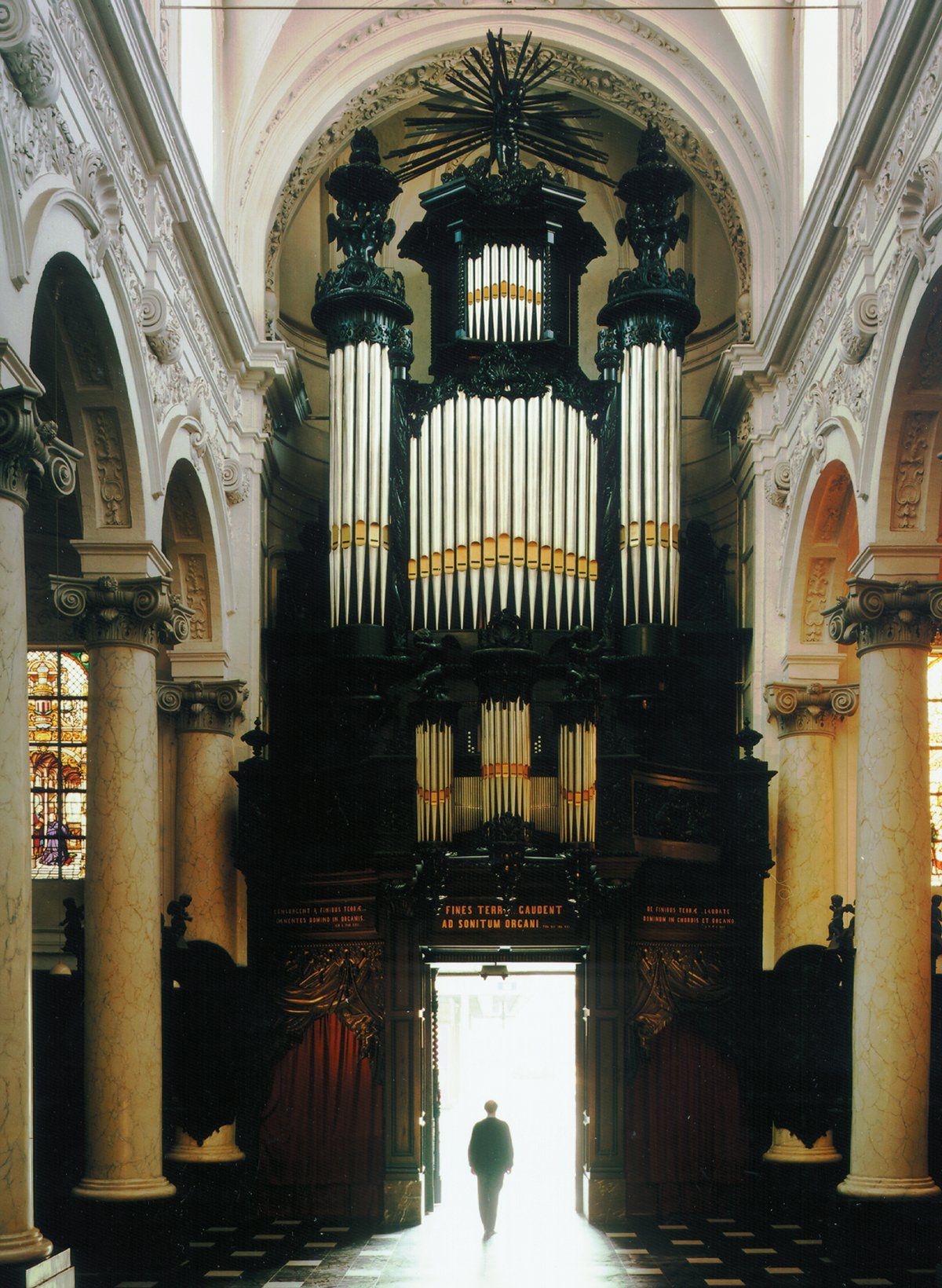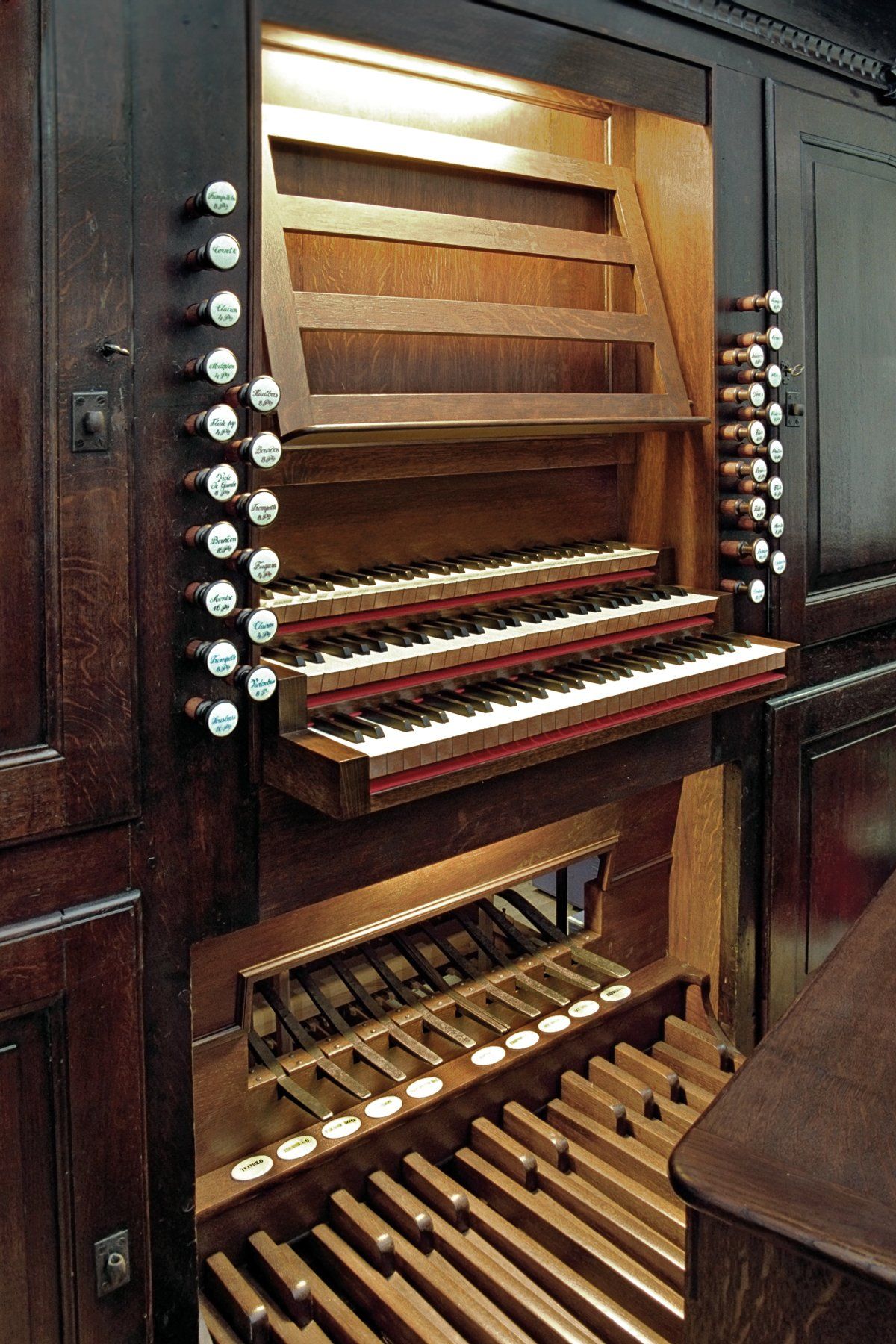Organ directory
Our Lady of Finisterrae church
Hippolyte Loret 1856 Organ - Thomas 2000
Organ builder : Hippolyte LORET (1856)
Restoration : Manufacture THOMAS, Ster-Francorchamps (2000)
The first contract for this organ was signed in 1848 by the Brussels organ builder Hippolyte Loret and the instrument was played for the first time "on the first Saturday of February of 1849”. It is very likely that the placement of the pedal stops, and some changes in the specification took place in the following years: an inaugural concert took place on February 4, 1856.
In 1950, Delmotte of Tournai electrifies the key as well as the register action, installs a new independent console, enlarges the compass of the pedal-board and introduces a new electro-pneumatic windchest for seven stops on the Positif. The disposition of the instrument is remodelled: many new stops are introduced and some Loret registers move from one keyboard to another. Such was the state of the organ when the Brussels firemen inundated it while extinguishing the fire of the tower on October 27, 1970.
During the last decade of the XXth century, the Finisterræ church underwent a complete architectural restoration and it was finally time for the organ to go through its long-awaited and well-deserved rehabilitation.
In 1996 CGER-Banque and CGER-Assurances decided to lead and finance the project. On April 24, 1998 the CGER board of directors signed the contract with the Manufacture d’orgues Thomas of Ster-Francorchamps.
The leading principle of this restoration has been to give its original physiognomy to the instrument. This involved the elimination of all the parts added to the organ after Loret, since they were not compatible with its proper function and its original sound aesthetic. As for the missing parts, models were found in the organ of Saint-Fiacre at Dison, built by Loret in 1867 the exact same year as that of Finisterræ. Useful information was also found in the organ of the abbey at Averbode, finished in 1859, and which Loret considered his masterpiece.
Thanks to this restoration, Brussels recovered a remarkable instrument, which stands as a unique testimony to the transitional period between early and romantic organ building. In this instrument, Hippolyte Loret demonstrates his capacities as innovator in many aspects: Grand-orgue windchest with double pallet box, allowing a system of Pédales de combinaisons very similar to Cavaillé-Coll’s invention, the presence of new kinds of registers, of free reed stops, and of the first swell box ever in the capital. Besides its particular, original and refined sonorities, this instrument, like all organs of quality, shall have the merit of stimulating curious organists to expand their repertoire as well as to reconsider their way of playing.
Disposition
| I. BOMBARDE | II. GRAND-ORGUE | III. POSITIF EXPRESSIF | PÉDALE | PÉDALE DE COMBINAISON (de gauche à droite) |
|---|---|---|---|---|
| Flûte traversière 8 | Montre 16 | Bourdon 16 | Contrebasse 16 | Trémolo Positif |
| Mélophone 4 | Bourdon 16 | Salicional 8 | Sousbasse 16 | Tirasse Grand-Orgue |
| Plein Jeu V | Montre 8 | Flûte harmonique 8 | Violon bas 8 | Tirasse clavier de Bombarde |
| Cornet bas III | Viole de Gambe 8 | Bourdon 8 | Octave basse 4 | Appel trompette basse 8 |
| Cornet haut V | Bourdon 8 | Voix céleste 8 | Bombarde 16 | Appel Trompette haute 8 |
| Trompette basse 8 | Prestant 4 | Fugara 4 | Trompette 8 | Appel anches du clavier de Bombarde |
| Trompette haute 8 | Flûte pyramidale 4 | Flûte 4 | Clairon 4 | Appel Clairon 4 |
| Clairon 4 | Trompette 8 | Accouplement du clavier de Bombarde au Grand-Orgue | ||
| Basson-Hautbois 8 | Accouplement du Positif au Grand-Orgue | |||
| Expression |
Discography
-
Bruxelles, Notre-Dame du Finistère
ButtonXavier Deprez
Jean Ferrard
Bernard Foccroulle
Momoyo Kokubu
Inauguration de l’orgue restauré
de Notre-Dame du Finistère
SIC-006






